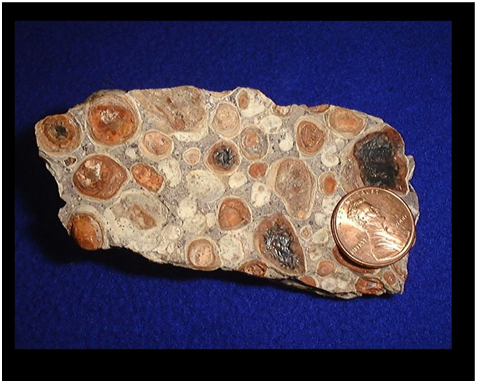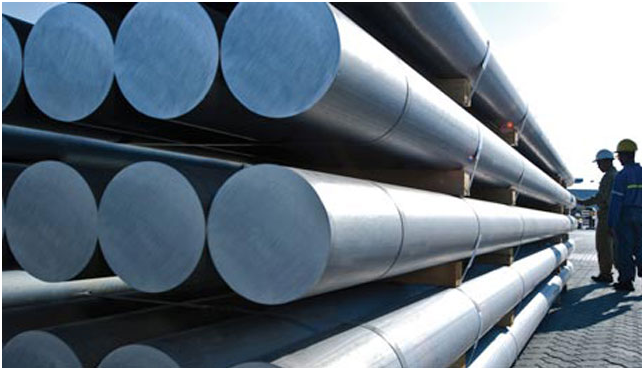Continued from 1. GDP 1: A look into World’s GDP until now
Making a television!
Let’s take an example: a television. A television is made from many minerals[i]. Usually plastics or aluminium make the most weight in a television amongst the hundreds of minerals used in it. To simplify the imagination, let’s assume that the whole television is made out of just one mineral – Aluminium. Aluminium is the second-most abundant metallic element in Earth’s crust [ii]after silicon. It makes to about 8 percent of the Earth’s crust by weight. It is found in Bauxite, a sedimentary rock with relatively high aluminium content. It is the world’s main source of aluminium and contains only 30–60% aluminium oxide.

Figure 6: [iii]Bauxite with US Penny for Comparison
The aluminium oxide must be purified before it can be refined to aluminium metal. To process aluminium existing in it’s natural form into an usable form, it takes in reality many companies. This sequence of companies with each company processing one or more steps and handing over to the next company is called supply chain. A simplified supply chain for Aluminium processing can looks like in the following paragraph.
Supply chain of Aluminium[iv]
Company 1 establishes in the market as an Aluminium extractor. It employs labour and uses machines to mine bauxite. The bauxite is refined to white powder called Alumina and sold to an Aluminium smelter, the Company 2.

Figure 7 & Figure 8
Company 2 uses energy to heat up the ore to extract its metal. Some two tonnes of alumina are needed to produce one tonne of aluminium through an electrolytic process. A smelter gives out Aluminium as slabs.

Figure 9
Slabs are transported to a Casting company 3 which cuts it to billets that are convenient for storage and shipping.

Figure 10
Company 4 then buys these billets, extrudes and stretches it to flat plates and sells it to Company 5 which cuts it into size and polishes the surface. The manufacturer of products which we use in daily life is the company 6 – a television manufacturer in our case, who usually places orders to Company 5. They explain the shape and size of their need in the product, and company 5 prepares them accordingly. The television manufacturer assembles it into their final product and hands it over to a distributor or showroom company 7 which takes the product to the end user who is you and me.
Sample Scenario
Each company on the supply chain, if they would increase the volume of production, they will earn more money as long as there are takers. Increase in money with all the companies in the chain means that the government can also make lots of money by taxing them. For an interested government to multiply their wealth, the only problem in the puzzle is that in the end of the supply chain, there will be too many televisions coming out. If no one buys it, the company 7 will not earn money and it will not make orders to company 6, company 6 will not order from 5 and so on till the company 1. Either the factories will be shutdown and workers will lose all their jobs or if they should continue to produce, there will be humongous unsold inventory of aluminium somewhere along the chain. In such a case, the Government cannot risk to lose too many jobs, else it will have to support the people from its own pocket. The solution to avoid this loss would be to have more and more televisions get sold in the market. The government, to motivate the people to buy television, can give tax benefit to company 6 to make sure that the televisions could be produced and sold in the market for a cheaper price. The government would also support company 6 to come up with more innovative products provided they have better acceptance in the market than televisions. With support for funding or subsidies, Company 6 then will invest a lot in Research and development and simultaneously they could also hire the topmost celebrity to endorse their products.
You as the consumer
Given their investments to drive innovation, the company 6 will manage to release a new product successively every few months or years. Their product catalogue will add a tablet, a play station and a smart TV. You, your wife and kid would see people around starting to buy them, having benefits and fun with the devices and now you might also want to have them. Your doctor will want to have those devices too and will start to increase the bill to the patients. Likewise your kid’s teachers and other service providers will slowly increase their bills too. Because of the higher bills that you will have to pay for your services, your budget will increasingly start to hurt and at the same time you want the devices too. Every year your salary will have increased due to your performance and you would even get an additional bonus from the company. Still this wouldn’t be enough. When more people will get into this trouble, things will escalate and will necessitate the government to interfere in the process. The government already had reduced the taxes for the company before and now it will have to support the consumers and get them these benefits. It will then set a minimum wage to increase the wallets of people so that they can also add these products to their lifestyle. You will start to receive a higher salary. The people who did not get a raise, will quit their job and take a second job by negotiating a higher salary at the first place. With successive increase in salaries, you would have bought a tablet for your wife. Two years later, you would have saved up more money and got a play station for your kid. Soon enough with successive increments in your salary, you would buy a smart TV and you would even get a second television to yourself too as your old one had started to perform slow. The common point in all those products is that all of it has aluminium. With increase in sale of televisions and the new innovations, more and more Aluminium got to be produced. Although the products could last for 10 years, every new product got increasingly attractive, that the consumers will choose to dispose the old ones and replace it with new ones every couple of years. The new products will have aluminium too and in this way we as active consumers will be driving the whole supply chain upstream till the company 1!
You as the worker!
Now the twist in the story! In reality you are not just the consumer, you are likely to be a worker in one such industry too!. Every time you or the labour union has been asking for more wages, the industry gave it. In our example, as the Aluminium industry was thriving, the government was able to set a minimum wage and ask the companies to increase the wage of their employees. The companies were able to afford, as consumers were increasing willing to buy televisions and other products which had Aluminium. The sample scenario above considered, for the sake of discussion, just one mineral in the product, while in reality we have multiple minerals in any product. In 2018, just the world aluminium industry directly employed about a million people and indirectly supported 5 million jobs. This is just for one mineral. Take all the minerals in the world; it could cover over 22% of the total employments in the world. Taking this supply chain as a reference and drawing parallel to what happened in the 1950s, world governments decided with every consecutive year to drive mineral extraction as much as possible. It earned money through Income tax from the company, Income tax from you as a worker and Sales tax from you as a consumer too. Because televisions and other innovative products were produced in humongous quantities, the government decided to export them and earned even a lot from selling to the foreign markets! The market thrived and there was more and more money getting generated. Households got increasingly filled with diverse products. This never-ending cycle is the phenomenon called consumerism: a market where there is no regulation or limits on how much a consumer can buy!
To be continued … 3. Rise of consumerism
References:
[i] http://www.answers.com/Q/What_metals_are_used_in_a_television_set
[ii] https://www.livescience.com/28865-aluminum.html
[iii] https://en.wikipedia.org/wiki/Bauxite
[iv] https://www.aluminiumleader.com/economics/how_aluminium_market_works/
If you like my posts, please acknowledge your motivation by Following/ Liking/ commenting on this blog. Thanks for reading.

3 thoughts on “GDP 2: Supply chain of a Television, a case study”